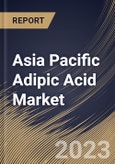Adipic acid prices mainly depend on the availability of raw materials, namely cyclohexanol and cyclohexanone, and demand from end-use sectors such as food & beverages, textile, pharmaceuticals, and personal care. BASF SE, Asahi Kasei Corporation, Lanxess, and Invista are major companies operating in this space.
Due to its toxicity, adipic acid poses severe threats to the environment. As per the New Jersey Department of Health and Senior Services, direct exposure to adipic acid can cause skin and ocular irritation and other health problems. Continuous exposure to this acid can also cause severe health conditions, such as cancer and reproductive disorders. Moreover, releasing adipic acid into natural water sources such as lakes, rivers, and ponds can be fatal to marine life, including invertebrates, fish, and aquatic vegetation. Therefore, the governing bodies of various nations have imposed multiple restrictions on the production, sale, distribution, and use of adipic acid. This is expected to restrain the growth of the market over the forecast period.
According to Invest India, India's domestic apparel & textile industry contributes approx. 2.3 % of the country's GDP and 7% of industry output in value terms. The share of textile, apparel, and handicrafts in India's total exports was 11.4% in 2020-21. India's textile exports were highest in FY 2021-22, crossing US$ 44 Bn. Adipic acid is a key raw material for producing nylon 6,6, a strong and durable synthetic polymer in the textile industry. It creates nylon fibers, fabrics, and yarns for various textile and apparel applications. India is a significant hub for apparel manufacturing and exports. The use of adipic acid-derived nylon materials in clothing, sportswear, hosiery, and fashion accessories is common in the country. The aspects mentioned above will expand the market growth in this region.
According to the State Council of China, in 2022, the added value of major electronics manufacturers rose 12.7 percent year-on-year, compared with the 7.5 percent growth seen in the overall industrial sector. The expanding electronics industry in China, which includes both domestic production and export-oriented manufacturing, leads to the demand for materials that meet the sector's stringent requirements. Adipic acid-based materials provide insulation, protection, and durability for electronic components, making them valuable in the context of the growing electronics industry in China. Manufacturers and suppliers in the market can collaborate with the Chinese electronics industry to offer solutions that align with its evolving needs. The aspects mentioned above will expand the market growth in this region.
The China market dominated the Asia Pacific Adipic Acid Market by Country in 2022, and would continue to be a dominant market till 2030; thereby, achieving a market value of $638.8 million by 2030. The Japan market is registering a CAGR of 3.6% during (2023 - 2030). Additionally, The India market would showcase a CAGR of 4.9% during (2023 - 2030).
Based on Application, the market is segmented into Nylon 6, 6 Fiber, Nylon 6, 6 Resin, Polyurethane, Adipate Esters, and Others. Based on End-use, the market is segmented into Automotive, Packaging & Consumer Goods, Electrical & Electronics, Textile, Building & Construction, and Others. Based on countries, the market is segmented into China, Japan, India, South Korea, Singapore, Malaysia, and Rest of Asia Pacific.
The market research report covers the analysis of key stake holders of the market. Key companies profiled in the report include Ascend Performance Materials LLC, Asahi Kasei Corporation, BASF SE, Koch Industries, Inc. (Invista BV), Liaoyang Tianhua Chemical Co., Ltd, Radici Partecipazioni S.p.A., Solvay SA, Sumitomo Chemical Co., Ltd., DOMO Chemicals GmbH, and LANXESS AG.
Scope of the Study
Market Segments Covered in the Report:
By Application (Volume, Kilo Tonnes, USD Million, 2019-2030)- Nylon 6, 6 Fiber
- Nylon 6, 6 Resin
- Polyurethane
- Adipate Esters
- Others
- Automotive
- Packaging & Consumer Goods
- Electrical & Electronics
- Textile
- Building & Construction
- Others
- China
- Japan
- India
- South Korea
- Singapore
- Malaysia
- Rest of Asia Pacific
Key Market Players
List of Companies Profiled in the Report:
- Ascend Performance Materials LLC
- Asahi Kasei Corporation
- BASF SE
- Koch Industries, Inc. (Invista BV)
- Liaoyang Tianhua Chemical Co., Ltd
- Radici Partecipazioni S.p.A.
- Solvay SA
- Sumitomo Chemical Co., Ltd.
- DOMO Chemicals Gmbh
- LANXESS AG
Unique Offerings
- Exhaustive coverage
- The highest number of Market tables and figures
- Subscription-based model available
- Guaranteed best price
- Assured post sales research support with 10% customization free
Table of Contents
Companies Mentioned
- Ascend Performance Materials LLC
- Asahi Kasei Corporation
- BASF SE
- Koch Industries, Inc. (Invista BV)
- Liaoyang Tianhua Chemical Co., Ltd
- Radici Partecipazioni S.p.A.
- Solvay SA
- Sumitomo Chemical Co., Ltd.
- DOMO Chemicals Gmbh
- LANXESS AG
Methodology

LOADING...








